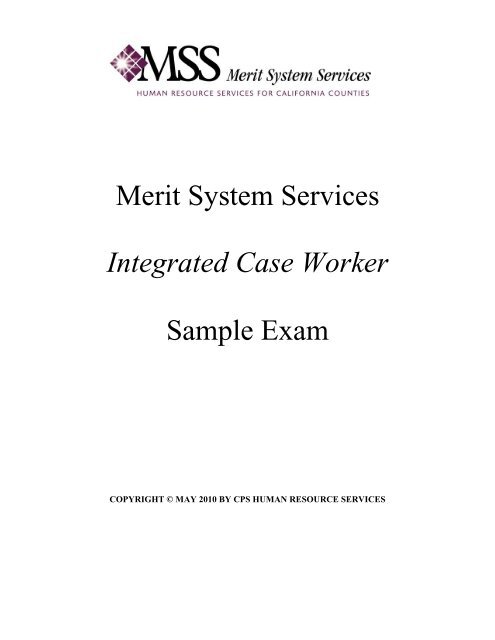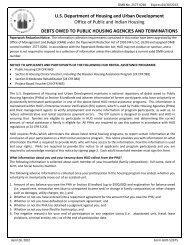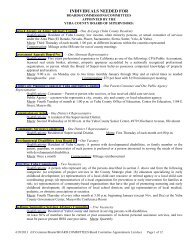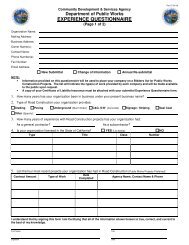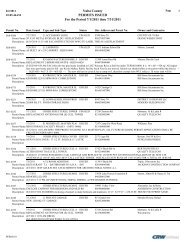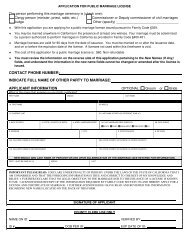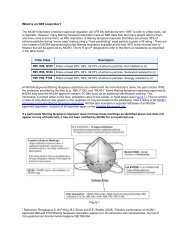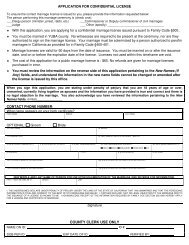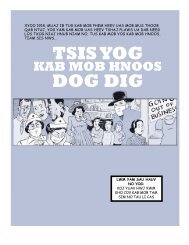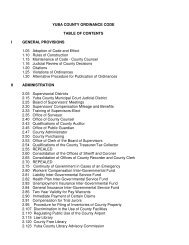Integrated_Case_Worker_Sample_Exam Merit System Services.pdf
Integrated_Case_Worker_Sample_Exam Merit System Services.pdf
Integrated_Case_Worker_Sample_Exam Merit System Services.pdf
Create successful ePaper yourself
Turn your PDF publications into a flip-book with our unique Google optimized e-Paper software.
<strong>Merit</strong> <strong>System</strong> <strong>Services</strong><br />
<strong>Integrated</strong> <strong>Case</strong> <strong>Worker</strong><br />
<strong>Sample</strong> <strong>Exam</strong><br />
COPYRIGHT © MAY 2010 BY CPS HUMAN RESOURCE SERVICES
SECTION 1<br />
READING COMPREHENSION<br />
DIRECTIONS: The following questions are designed to measure your ability to read and understand<br />
written material. Each reading passage is followed by one or more questions about the material you<br />
have read. Base your answers only on the material you have read and not on any prior knowledge you<br />
may have. Darken the box corresponding to the single best answer for each of the questions.<br />
Employees are encouraged to participate in training opportunities that improve their job knowledge and<br />
skills. Employees will be reimbursed for the cost of job-related training opportunities when funds are<br />
available. These training opportunities include seminars, conferences, and courses offered by vendors or<br />
various professional or educational institutions and associations. Supervisory approval is necessary for<br />
training attendance during normally scheduled work hours. Personnel requesting reimbursement must<br />
submit a copy of the training request approved by their supervisor to the HR department at least twoweeks<br />
prior to attending the training.<br />
1. According to the passage<br />
a. job-related training opportunities must be approved by the employee’s supervisor.<br />
b. only training completed during work hours is eligible for reimbursement.<br />
c. reimbursement requests must be approved by the employee’s supervisor.<br />
d. all job related training expense are reimbursed by the HR department.<br />
Within the business world, there is an increase in the popularity of telecommuting. Organizations can<br />
take advantage of information technology to allow more employees to work from home without a loss in<br />
productivity. This provides organizations the flexibility of paying for office space and infrastructure on<br />
an as-needed basis.<br />
2. Based on the reading passage, the primary advantage of telecommuting for organizations is<br />
a. increased productivity of employees working remotely.<br />
b. reduced need for employee labor due to better technology.<br />
c. a reduction in the amount of salary that must be paid to employees.<br />
d. a reduction in physical facilities costs.
MEMORANDUM<br />
DATE: April 27, 2010<br />
To: All permanent, probationary, and limited-term staff<br />
From: Richard Tamah, Social <strong>Services</strong> Director<br />
Subject: Confidentiality Reminder<br />
Client confidentiality is one of the most important aspects of the service that we provide to our clientele.<br />
Clients expect and are entitled to have their confidentiality protected. It has come to the attention of<br />
management that confidential information shared between a client and his/her case worker has been<br />
discussed in the office by staff who were not directly involved with the case.<br />
Although the discussions reflected sympathy and concern for the affected client and his/her family, it<br />
must be remembered that what appears to be a harmless discussion on the surface can be construed as a<br />
breach of client confidentiality. Discussing a client’s case with uninvolved staff is not only disrespectful<br />
to the client, but can lead to feelings of mistrust between our agency and our clients. Without trust, we<br />
will be unable to properly fulfill our agency’s mission in serving those in need. If any staff member is<br />
having difficulty with a case, please seek the assistance of your direct supervisor.<br />
In some situations, a supervisor may be able to use a difficult case as a learning tool by leading a<br />
discussion with staff as a group. However, the only time that sensitive case information can be<br />
discussed by staff not directly assigned to the case is when it meets the three conditions of an exempted<br />
learning opportunity:<br />
1) A supervisor believes the case is a unique learning opportunity,<br />
2) the client has given the supervisor written permission, and<br />
3) the supervisor leads the discussion in a secure confidential area.<br />
Please discuss any client related questions with your direct supervisor; do not discuss them with<br />
colleagues.<br />
RT
DIRECTIONS: Answer the following question(s) based on the information given on the<br />
previous page(s). Darken the box on your answer sheet corresponding to the single best answer<br />
for each of the question(s).<br />
3. The main purpose of the memo is to<br />
a. define which topics can be informally discussed by staff.<br />
b. describe the specifics about a recent case of breached confidentiality.<br />
c. explain how sensitive case information is to be handled by staff.<br />
d. discuss how supervisors can use difficult cases for training opportunities.<br />
4. In which situation can staff not directly assigned to a case discuss that case with other<br />
staff<br />
a. when the case represents a unique learning opportunity<br />
b. when the discussion is held in private<br />
c. when a supervisor leads the discussion<br />
d. when the client has given permission<br />
5. The most important reason that sensitive case information should not be discussed<br />
informally among staff members is that<br />
a. clients may become unwilling to share important information with their<br />
caseworkers.<br />
b. supervisors may be less aware of difficult cases.<br />
c. facts about a client’s case may be distorted unintentionally.<br />
d. training opportunities will be more difficult to locate.
SECTION 2<br />
INTERVIEWING<br />
DIRECTIONS: The following questions are designed to measure your ability to conduct<br />
interviews for the purpose of determining eligibility for program assistance. Darken the box on<br />
your answer sheet corresponding to the single best answer for each question.<br />
6. Which interview approach is best for getting a client to answer questions about a<br />
sensitive topic<br />
a. Ask a series of broad questions before asking more focused questions about the<br />
sensitive topic.<br />
b. Ask a series of direct questions about the sensitive topic before asking broader<br />
questions.<br />
c. Ask for the client’s demographic information first and then proceed to the focused<br />
questions about the sensitive topic.<br />
d. Ask a broad open ended question about the client’s background and listen for<br />
information about the sensitive topic.<br />
7. The most important reason that an interviewer needs to understand the purpose of each<br />
interview question is to<br />
a. know when the answer provided by the client is sufficient.<br />
b. be able to change the wording of questions when necessary.<br />
c. instill confidence in the client during the interview.<br />
d. know which questions are applicable.<br />
8. An interviewer who noticeably nods her head during client responses to interview<br />
questions may<br />
a. reduce the need to rephrase questions.<br />
b. reduce the accuracy of the responses provided by the client.<br />
c. increase the accuracy of the responses provided by the client.<br />
d. increase the client’s trust in the interviewer.
9. Which type of interview provides the interviewer flexibility to adapt interview questions<br />
based on the topics mentioned by the interviewee<br />
a. structured interview<br />
b. unstructured interview<br />
c. background interview<br />
d. behavioral interview<br />
10. In which situation should a probing question be used<br />
a. to open the interview<br />
b. to build rapport with the client<br />
c. when you believe the client has not said everything she knows<br />
d. when the client doesn’t understand the original question
SECTION 3<br />
CUSTOMER SERVICE PRINCIPLES<br />
DIRECTIONS: Darken the box on your answer sheet corresponding to the single best answer for<br />
each question.<br />
11. How should you initially handle a customer who appears very angry or frustrated<br />
a. Allow her an opportunity to express their feelings.<br />
b. Ask her to try and think reasonably about the situation.<br />
c. Provide her with facts and information about the situation.<br />
d. Offer to compensate her for their time and trouble.<br />
12. Which is the best response to a frustrated customer’s request that you know cannot be<br />
met<br />
a. “I will try to get that done.”<br />
b. “I don’t know if that can be done.”<br />
c. “We don’t normally meet that type of request.”<br />
d. “Here is what I can do.”<br />
13. One of the best methods for ensuring that you have correctly understood what a customer<br />
has said is to<br />
a. repeat what the customer said using the customer’s own words.<br />
b. restate what the customer said using your own words.<br />
c. ask the customer to repeat the statement.<br />
d. ask the customer a series of closed ended questions about what was said.<br />
14. During a face-to-face conversation, which characteristic of the speaker has the greatest<br />
influence on the message that is received by the listener<br />
a. body language<br />
b. vocal tone<br />
c. choice of words<br />
d. physical appearance
15. Using acronyms when speaking with customers is likely to<br />
a. make it more difficult for customers to understand what you said.<br />
b. convey a sense of expertise and command of the subject matter to customers.<br />
c. allow you to get to important points more quickly.<br />
d. reduce the need for lengthy and confusing explanations.<br />
16. When a customer speaks to you using a fairly slow rate of speech, your response should<br />
be spoken at<br />
a. a rate that is slightly faster than your customer’s.<br />
b. a rate that is similar to your customer’s.<br />
c. your normal rate of speech.<br />
d. a rate that is slightly slower than your customer’s.
SECTION 4<br />
WRITTEN COMMUNICATION<br />
DIRECTIONS: The following sentences are designed to measure your knowledge of<br />
punctuation. For each item, select the sentence that contains an error in punctuation. Then<br />
darken the box on your answer sheet that corresponds to your selection.<br />
17. a. Thank you, Ms. Lane, for all that you have done for the organization.<br />
b. To whom should this letter of reference be addressed<br />
c. We didn’t finish by the projected deadline; consequently, we now have to put in<br />
overtime.<br />
d. The work was completed on schedule but it didn’t meet the client’s needs.<br />
18. a. The required steps are as follows: establishing eligibility criteria, screening, and<br />
providing services that meet the eligibility criteria.<br />
b. The enclosed test, Form B, is representative of the entry-level written tests.<br />
c. The conference will be held on Wednesday, October 3, in San Francisco.<br />
d. He provided them with a stern warning, however; it was ignored.<br />
DIRECTIONS: The following items are designed to measure your ability to identify words that<br />
are spelled incorrectly. For each item, choose the one word which is misspelled. Darken the box<br />
on your answer sheet that corresponds to the misspelled word.<br />
19. a. laison<br />
b. briefing<br />
c. conscientious<br />
d. referring<br />
20. a. temperamental<br />
b. legitamate<br />
c. accommodate<br />
d. condemn
DIRECTIONS: The following questions are designed to measure your knowledge of English<br />
grammar. For each question, select the sentence that is grammatically incorrect. Darken the box<br />
on your answer sheet corresponding to the single best answer.<br />
21. a. It is important that all reports contain a discussion of plausible explanations.<br />
b. The format used for a report should be determined by the report’s purpose.<br />
c. The layout of a descriptive or analytical report depend on how the information<br />
will be used.<br />
d. Meaningful information in a variety of styles demands timeliness and adequate<br />
detail.<br />
22. a. I sent copies of the report to both offices.<br />
b. Kim and Terri were driving to the conference.<br />
c. John and I will be attending the softball game.<br />
d. Kelli couldn't of been at the office any sooner due to traffic.<br />
DIRECTIONS: The following items are designed to measure your vocabulary knowledge. For<br />
each capitalized word, select the one word below it which is closest in meaning. Darken the box<br />
on your answer sheet that corresponds to the single best answer for each of the following<br />
questions.<br />
23. STRATIFY<br />
a. remove<br />
b. layer<br />
c. displace<br />
d. build<br />
24. PERVASIVE<br />
a. extensive<br />
b. ambiguous<br />
c. trivial<br />
d. direct
SECTION 5<br />
BENEFIT CALCULATIONS<br />
BENEFIT PROGRAM RULES:<br />
1. A family can receive either the monthly maximum allowance or the sum of the maximum<br />
monthly needs allowances, whichever amount is lower.<br />
2. For the monthly maximum allowance, a child has to reside in the home for more than one<br />
week each month to earn the additional child allowance. Assume the child lives with the<br />
parent(s) full time unless otherwise noted.<br />
MONTHLY MAXIMUM ALLOWANCE<br />
Children in Family<br />
Maximum Allowance<br />
One Parent in Home 1 $450<br />
Two Parents in Home 1 $520<br />
(Add $45 for each additional child)<br />
MAXIMUM MONTHLY NEEDS ALLOWANCES<br />
Need<br />
Number of Persons in Family<br />
1 2 3 4 5 6 over 6<br />
Housing $200 $225 $300 $350 $450 $500 $600<br />
Food $40 $53 $64 $79 $88 $93 $106<br />
Utilities $15 $18 $26 $38 $43 $57 $73
DIRECTIONS: Answer the following question(s) based on the information given on the<br />
previous page(s). Darken the box on your answer sheet corresponding to the single best answer<br />
for each of the question(s).<br />
25. What is the monthly maximum allowance for a single parent with three children<br />
a. $495<br />
b. $520<br />
c. $540<br />
d. $585<br />
26. Mr. and Mrs. Seifer have five children who live with them full time and one daughter<br />
who lives with them every other weekend. What is their total monthly allowance<br />
a. $695<br />
b. $700<br />
c. $745<br />
d. $779<br />
27. What is the total monthly allowance for a single parent family of seven<br />
a. $720<br />
b. $745<br />
c. $765<br />
d. $779
Monthly Food Assistance Allotment: Use the chart below to determine the amount of food<br />
assistance available to a household based on the number of persons living in that household and<br />
the household’s net monthly income. For benefit allotment purposes, a person is considered a<br />
household member if that person has lived in the residence for a continuous period of at least<br />
nine months out of the previous 12 months. A household’s food assistance allotment is increased<br />
by 10% if more than three persons living in the household are 16 years of age or older.<br />
Monthly Net<br />
Income<br />
Food Assistance Allotment by Household Size<br />
Number of Persons in the Household<br />
1 2 3 4 5 6<br />
Less than $400 $35 $64 $92 $117 $139 $166<br />
$400 - $599 $34 $63 $91 $116 $138 $166<br />
$600 - $799 $34 $63 $90 $115 $137 $165<br />
$800 - $999 $33 $62 $90 $115 $137 $165<br />
$1,000 - $1,199 $33 $62 $89 $114 $136 $164<br />
$1,200 - $1,399 $32 $61 $89 $114 $136 $164<br />
$1,400 - $1,599 $32 $61 $88 $113 $135 $163<br />
$1,600 - $1,799 $30 $60 $88 $113 $135 $163<br />
$1,800 - $2,000 $30 $60 $87 $112 $134 $162<br />
More than $2,000 $29 $59 $87 $112 $134 $162
DIRECTIONS: Answer the following question(s) based on the information given on the<br />
previous page(s). Darken the box on your answer sheet corresponding to the single best answer<br />
for each of the question(s)<br />
28. Two adults and two children (ages 10 and 16) are living in a household with a monthly<br />
net income of $1,978. What is their food assistance allotment<br />
a. $60.00<br />
b. $66.00<br />
c. $112.00<br />
d. $123.20<br />
29. Three adults and two children (ages 14 and 17) are living in a household with a monthly<br />
net income of $682. What is their food assistance allotment<br />
a. $90.00<br />
b. $99.00<br />
c. $137.00<br />
d. $150.70<br />
30. What is the maximum food assistance allotment available for a household with one adult<br />
and two children (ages 16 and 17)<br />
a. $87.00<br />
b. $92.00<br />
c. $95.70<br />
d. $101.20


